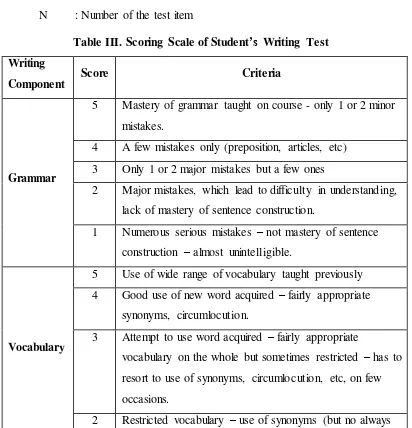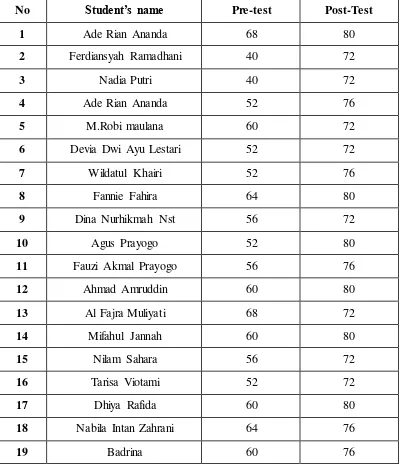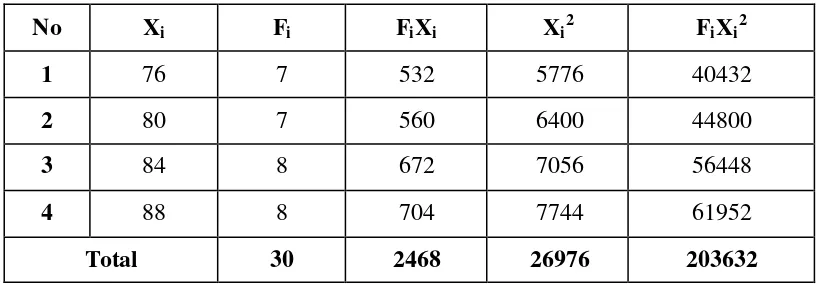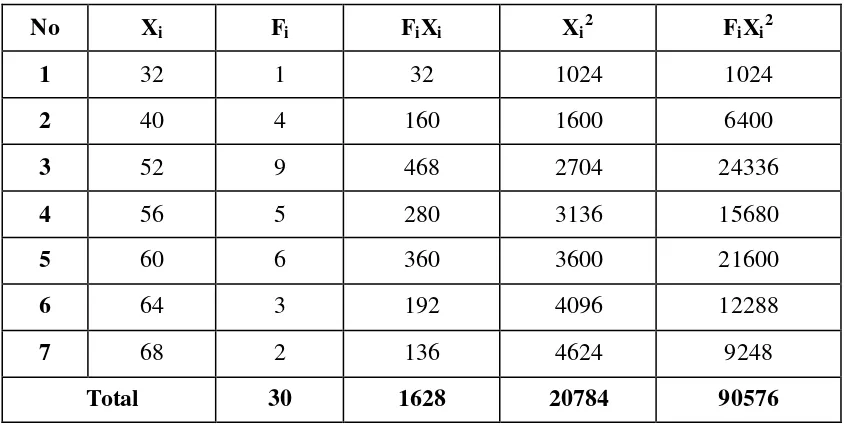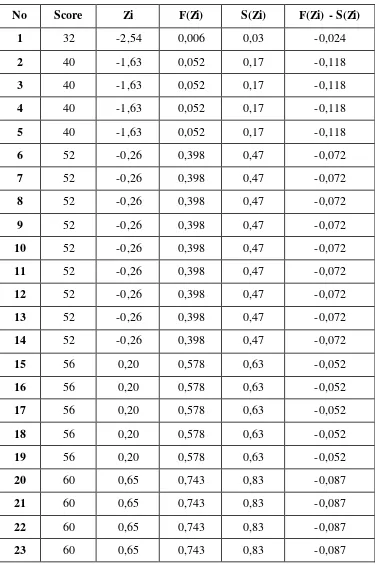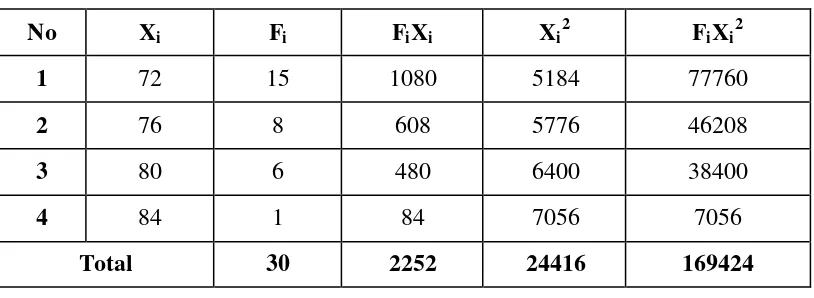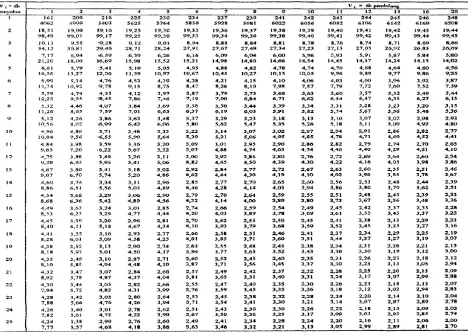1
THE EFFECT OF BRAINSTORMING TECHNIQUE IN WRITING DESCRIPTIVE TEXT AT VIII GRADE OF MTsN STABAT
IN 2016/2017 ACADEMIC YEAR
SKRIPSI
Submitted to the Tarbiyah Faculty and Teachers Training State University for Islamic Studies (UIN) North Sumatera Medan as a Participle Fullfillment
Requirement For S1 Degree By:
SHELA RIZKINA NIM: 34.13.3.057
DEPARTMENT OF ENGLISH EDUCATION FACULTY OF TARBIYAH AND TEACHER TRAINING STATE ISLAMIC UNIVERSITY OF NORTH SUMATERA
ACKNOWLEDGEMENT
In the name of Allah SWT, the beneficent and merciful. Praise be to
Allah, the lord of the universe, by the whole modest heart. The writer would like
to express her thankfulness to Allah SWT that has given her health and safety, so
that the skripsi which is entitled: “The Effect of Brainstorming Technique in
Writing Descriptive Text at VIII Grade in MTsN Stabat” has been finished. Peace
and blessing be upon to the prophet Muhammad SAW, his families, his relatives
and all his followers.
This skripsi was written as a partial to fulfillment of the requirement for
S-1 program at State Islamic University of North Sumatera (UIN-SU) Medan.
In completing this, the writer had encountered some difficulties,
especially in collecting and analyzing data and the writer also realized that
without much help from numerous people, this skripsi would have not much help
completed as it is. Concerning with this completion of this skripsi. The writer like
to thanks to the following people:
1. Dr. Amirruddin Siahaan, M.Pd as the dean of Faculty of Tarbiyah and
Teacher Training State Islamic University of North Sumatera
2. Dr. Abdillah, S.Ag, M.Pd and Dr. Derliana Marbun, M.Pd as my advisor
who has guide and given advice for me also some suggestion for writing
The words are not enough to say appreciation for your help and
contribution on this skripsi. May Allah always give happiness in our life.
Medan, April 2017
The Writer
5
ABSTRACT
SHELA RIZKINA. THE EFFECT OF BRAINSTORMING TECHNIQUE IN WRITING DESCRIPTIVE TEXT AT VIII GRADE OF MTsN STABAT IN 2016/2017 ACADEMIC YEAR.
Skripsi, Medan: Department of English Education, Faculty of Tarbiyah Science and Teachers Training, State Islamic University of North Sumatera, Medan 2017.
Keywords: Brainstorming Technique, Writing Descriptive Text
This research was intended to find out the empirical evidence of the
students‟ achievement by using brainstorming technique in learning writing
descriptive text at VIII grade MTsN Stabat.
This research was quantitative research. The population of this research
was all student‟s class VIII MTsN Stabat. The sample of this research were taken ttest was 2.917 and ttable was 2.009.
So, the ttest was higher than ttable. It means that there was significant effect
of using Brainstorming Technique on students‟ achievement in writing
TABLE OF CONTENT
ABSTRACT ... i
ACKNOWLEDGMENT... ii
TABLE OF CONTEN TS... v
LIST OF TABLES ... vii
LIST OF APPENDICES ... viii
CHAPTER I: INTRODUCTION ... 1
A. Background of Study... 1
B. The Problem of Study ... 3
C. The Objectives of the Study ... 3
D. The Scope of The Study ... 3
E. The Significances of the Study ... 3
CHAPTER II: THEOR ETICAL FRAMEWORK ... 4
A. Theoretical Framework ... 4
1. Definition of Writing ... 4
2. Writing Process ... 6
3. Genre of Writing ... 8
3.1 Descriptive Text ... 9
3.2 Parts of Descriptive Text ... 10
7
4. Brainstorming Technique ... 12
4.1 Definition of Brainstorming Technique ... 12
4.2 The Steps of Brainstorming technique ... 12
4.3 The Advantages of Brainstorming Technique ... 13
B. Conceptual Framework ... 15
C. Hypothesis ... 16
CHAPTER III: R ESEARCH METHODOLOGY ... 17
A. Location of Research ... 17
B. Research Design ... 17
C. Population and Sample ... 18
D. The Instrument for Collecting Data ... 19
E. Techniques of Collecting Data ... 19
1. Pre Test ... 20
2. Treatment ... 20
3. Post Test ... 20
F. Scoring the Test ... 21
LIST OF TABLE
Table
I The Research design ... 18
II Sample ... 19
III Scoring Scale of Student‟s Writing Text ... 21
IV Table Score in Experimental Group ... 24
V Table Score in Control Group ... 26
VI Frequency Distribution of Pre-Test in Experimental Group ... 28
VII Normality Testing of Pre-Test in Experimental Group ... 30
VIII Frequency Distribution of Post-Test in Experimental Group ... 32
IX Normality Testing of Post-Test in Experimental Group ... 34
X Frequency Distribution of Pre-Test in Control Group ... 36
XI Normality Testing of Pre-Test in Control Group ... 38
XII Frequency Distribution of Post-Test in Control Group ... 40
XIII Normality Testing of Post-Test in Control Group ... 42
XIV Mean of Post-Test – Pre-Test in Experimental Group ... 45
9
LIST OF APPENDICES
Appendix A : Lesson Plan 1 in Experimental Group
Appendix B : Lesson Plan 2 in Experimental Group
Appendix C : Lesson Plan 1 in Control Group
Appendix C : Lesson Plan 2 in Control Group
Appendix D : Pre-Test
Appendix E : Post-Test
Appendix F : Documentation
Appendix G : The Critical Value Liliefors Table
Appendix H : Table of F Distribution
CHAPTER I INTRODUCTION
A. Background of the Study
There are four skills needed to master English. They are listening,
speaking, writing and reading. Speaking and writing involve languange
production, so it is regarded as productive skills. On the other hand, listening and
most students. In Indonesia, some English teacher still use conventional technique
to teach writing. Conventional technique usually makes students bored because
11
teacher should find the technique to overcome this problem. One of the ways to
make teaching writing effective is making the student active. The teacher should
apply appropriate teaching technique as well as method to establish the
effectiveness of English teaching. It will make easier and enjoyable for student
receive the lesson. If they have a good ability in writing, they will have a better
chance to succeed in their study. So that, English teacher should be creative and
selecting the technique to teach writing.
In line with this study, the writer think that the students may improve
their writing in descriptive text by Brainstorming technique. Therefore, the writer
choose “The Effect of Brainstorming Technique in Writing Descriptive Text
at VIII Grade in MTsN Stabat ” as the title of the study.
B. The Problem of the Study
Based on the background of study above, the problem of the study is as
follows: “Is there any significant effect of brainstorming technique on student‟s
writing descriptive text?”
C. The Objective of the Study
Based on the statements of the research problems above, the objectives of
the research is to find out whether there is any significant effect of using
D. The Scope of the Study
This study is focused on applying Brainstorming technique on students‟
writing descriptive text.
E. The Significant of the Study
The study is expected to be significance as follows:
1. Theoretically, to help teacher to find out alternative way of teaching
writing.
2. Practically, it can be used as a technique to improve the student‟s writing
13
the same perspective of implementation in the field and avoid misunderstanding.
Translation:
4. Who has taught (the writing) by the pen (the first person to write was Prophet
Idrees). 5. Has taught man that which he knew not”.1
From the verse above we can see in the fourth and fifth verse that Allah
Muhammad Muhsin, The Nobel Quran English Translation of Meaning and the
15
Harmer (2004:31) states that writing as one of the four skills has always
formed part of the syllabus in the teaching of English. However, it can be used for
a variety of purposes ranging from being merely a backup for grammar teaching
to a major syllabus stand in its own right where mastering the ability to write
effectively is seen as a key objective for learners.2
According to Utami Dewi (2009:9) “writing is the expression of
Jeremy Harmer, (2004), How to teach Writing, England: Longman, p. 31
3
Utami Dewi, (2013), How to write, Medan: La Tansa Press, p. 2
4
Ibid, p. 9
5
Fera Mursidah, (2011), Improving Students Writing Ability to Write Narrative
17
3) Editing (Reflecting and Revising)
called writing. Writing should be organized effectively and include aspects
such as ideas, word choice, grammar, control and coherent.9
3. Genre of Writing
Genre is a kind of text or writing work itself. It views that the language
(writing form) must be related to social function. Social function of the text then
implies a certain social environment and place where and when the text is used.10
There are various genres of text: Narrative, Descriptive, Procedure,
Recount, Explanation, Analytical Exposition, Hortatory Exposition, Report,
Anecdote, Spoof, Review, and News.
9
Jeremy Harmer, Op.Cit, p. 4-5
10
19
From the variety of genres above, the writer choose the genre of
descriptive to be applied in writing.
3.1 Descriptive Text
Description or descriptive text etymologically is derived from the
word “describe”. Describe means to draw, to illustrate or to picture object,
performs the appearance of thing by describing the details of subject.
3.2 Parts of Descriptive Text
In descriptive text writing, there are several things that should be
understood as a following:
1) Social Function
The social Function of descriptive text is to describe a particular
person, place, thing or animal.
11
Dirgeyasa, (2014), College Academic Writing: A Genre-Based Perspective, Medan: Unimed Press, p. xvii
12
2) Generic structure.13
The Generic structure of descriptive text is:
- Identification, which identifies phenomenon that will be describe.
- Description which describe about parts, qualities or characteristic
of something or someone in skill.14
and adverbial phrase are used most often.15
13
Peter Knap and Megan Watkins, (2005), Genre, Text, Grammar: Technologies
for Teaching and assessing Writing, Sidney: UNSW press, p. 98
14
Sanggam Siahaan and Kisno Shinoda, (2008), Generic Text Structure, Yogyakarta: Graha Ilmu, p. 89
15
21
3.3 Example of Descriptive Text
My close friend, Anisa
trouble and never discriminate friends.
4. Brainstorming Technique
4.1 Definition of Brainstorming Technique
Brainstorming means the use of brain to the active problem solving
and the brainstorming session aims to develop creative solutions to problems
(Jarwan,2005).16
4.2The Steps of Brainstorming Technique
There are some steps to do the brainstorming technique in making
descriptive text (http://brainstorming-technique.blogspot.com/). The teacher
can give explanation of descriptive text and ask the students to consider this:
the research gave the explanation of descriptive text as ask the student to:
Divide some groups consist of 3 members, the first students as a
speaker and second student as a writer.
Choose title based on the topic that given by teacher
16
F. Jarwan, (2005), Teaching Thinking: Definition and applications. Amman: Dar Al-fkir. Jordan.
17
A. Widowati, (2013), Brainstorming as An Alternative of Creative Thinking
23
Think of three of four categories that would serve as subtopics. They
can start by thinking how could be the best down their topic into
smaller section.
The first student talking everything what they think based on the topic
and subtopic, without worrying to make a mistake.
The second student write down what the speaker say each of their
subtopic, leaving a few inches of space between each item.
The third person makes bullets in each sentence. If they find need more
space than they have provides under each category, they can transfer
their subtopic to a new sheet of paper.18
4.3 The Advantages of Brainstorming Technique
Brainstorming activity can be done individually or in group. The
implementation of group brainstorming in the writing class provides some
advantages to the students. The advantages are presented as below:
1. It is stimulating and provides a varied instructional approach.
It generates enthusiasm and eagerness to join in by its open
invitation to participate and its rapid, free-wheeling approach.
2. It is highly motivating.
Students who usually allow their verbal, articulate classmates to
dominate question-and-answer periods get the urge to participate. They
are not "put down" or degraded for "wrong answers" and feel a real sense
18
of contribution as their suggestions are noted on the project sheets. On
the other hand, those who dominate traditional classroom situations are
also stimulated to get their ideas out and on the record.
3. It increases "task focus."
The brainstorming group is kept on target with very little
pressure from the group leader because of the structure and ground rules.
Editorializing, personal commentary, rejoinders, eloquent speeches, and
the other destructive activities of committees are eliminated in this
process.
4. It promotes spontaneity and creativity.
The members of the group begin to link ideas and "bounce
suggestions off the group" in a sounding-board procedure that gathers
momentum as the session continues. Mental power is fully unleashed in
assume group ownership of their ideas and suggestions. Problem solving
25
7. It provides a permanent record and aids in developing solutions to
problems.
The results of the sessions can easily be reproduced or reused to
design alternate procedures and programs for solving problems or
meeting objectives. The production of the group takes on value as a
permanent evaluation record and as testimony to individual and group
effort.
It can be concluded that brainstorming brings some benefits in
writing. The technique facilitates the students to generate ideas
effectively by giving them opportunity to explore their prior knowledge
about particular subjects. It would help the students to overcome the
problem related to the writer‟s block that usually faced by the students in
the early stage of writing.
B. Conceptual Framework
Conceptual framework is the related theoretical concept on all of the
variables that should be practically and empirically operated in this research
paper. Based on the title above the writer found that there are two variable. There
are the variable X which is known as an independent variable within telling about
the Brainstorming technique that refers to the teacher in teaching descriptive text
subject matter in experimental class at the second grade of MTsN Stabat.
Secondly is the dependent variable (variable Y) about student‟s writing at the VIII
Well, based on the explanation above we have already known that
writing is an activity to express ideas, thought, and feelings. Writing is the
interaction between writer and the reader it self in which the reader try to
understand what the text is talking about with using their prior knowledge in some
strategies.
Applying the technique in teaching is an effective way to make the
students more focus with the learning process. Technique also can decrease
students difficult or problem in learning. Such as in the writing learning process,
some students get a long time to write the text because they too pay attention for
grammar or it is connected with the other sentence or not. That‟s why the teacher
should use the technique in teaching.
C. Hypothesis
In accordance with theoretical and conceptual frame, the hypotheses are
formulated as follows:
H0 : There is no significant effect of applying Brainstorming technique in
writing descriptive text.
Ha : There is a significant effect of applying Brainstorming technique in
27
variables. There are, independent variable (variable X) about Brainstorming
technique and writing descriptive text as the dependent variable (variable Y). This
study is use the quantitative research in the experimental type. Experimental type
is the quantitative research that used the scientific method in which the researcher
takes the control among variables, manipulates one or more independent variables
to observe the result about any action.19
So, there are two groups students. The experimental group and the
control group. Experimental group is a group that receives the treatment and the
19
control group is as the standard of the comparison group which does not receive
the treatment.20
The research design can be figured as following table:
Table I
29
Experimental Brainstorming VIII-5 30 students
Control Conventionally VIII-6 30 students
Total 60 students
D. The Instrument for Collecting Data
For collecting the data, a writing test was used as the instrument. The test
E. The Technique of Collecting Data
sample are relatively homogeneous. This test was administered before giving
treatment. After that, the answer sheets were collected and scored by the
researcher.
2. Treatment
After giving the pre-test, the students were given the treatment. The
experimental group and control group were taught in different teaching
technique. The experimental group was taught by using Brainstorming
31
F. Scoring the Data
In giving the value of the data, the writer used the score ranging 1-5 by
counting the correct answer and applying this formula:
S = x 100
2 Major mistakes, which lead to difficulty in understanding,
lack of mastery of sentence construction.
1 Numerous serious mistakes – not mastery of sentence
construction – almost unintelligible.
Vocabulary
resort to use of synonyms, circumlocution, etc, on few
occasions.
appropriate) imprecise and vague affect meaning.
1 Very restricted vocabulary – inappropriate use of
synonyms seriously hinders communication.
Mechanic
Mechanic
5 No errors.
4 1 or 2 minor errors (e.g. ei or ie)
3 Several errors – do not interfere significantly with
communication – not too hard to understand.
2 An effort needed to understand and enjoy – some words
very hard to recognize
1 Numerous errors – hard to recognize several words –
communication made very difficult
relevance
5 All sentences support the topic – highly organized – clear
progression of ideas well linked educated native speaker
4 Ideas well organized – links could occasionally be clearer
but communication not impaired.
3 Some lacks of organization – rereading required for
clarification ideas.
2 Little or no attempts at connectivity – though reader
deduces some organization – individual ideas maybe clear
but very difficult to deduce connection between them
1 Lack of organization so serve that communication is
33
compound sentences.
1 Very jerky – hard to understand cannot enjoy reading –
almost all simple – complex sentences confusing –
excessive use of “and”
G. The Technique of Analyzing Data
To find the out the effect of using Brainstorming technique in writing
descriptive text, mean of the control class and the experimental class are
compared by using t-test, as follows:
T-test =
√
Where:
t-test = The effect
x1 = Mean of Post-test – Pre-test in experimental group
x2 = Mean of Post-test – Pre-test in control group
S12 = Variant of Pre-test – Post-test in experimental group
S22 = Variant of Pre-test – Post-test in control group
n1 = Sample in experimental group
34 A. The Description of Data
The data were collected by giving students a written test. In this research,
the sample was divided into experimental and control group. Each group were
given pre-test and post-test. The students at experimental group were taught by
using brainstorming technique while students at control group were taught by
using explanation method. The population of this research was the students of the
VIII grade in MTsN Stabat. The experimental group was VIII-5 and the control
group was VIII-6.
The research was conducted during in one month, within two treatments
which includes four meeting altogether. Both experimental and control group
were given essays writing test form on the pre-test and post-test. The data of this
research were the score of the pre-test and post-test score.
Table IV
Table Score of Pre-test and Post-test (Experimental Group)
No Student’s name Pre-test Post-Test
35
No Student’s name Pre-test Post-Test
descriptive text by using brainstorming technique showed the lowest score of
pre-test was 32, and the highest score of pre-pre-test was 68 and the average of pre-pre-test
was 54.40. On the other hand the lowest score of post-test was 76, and the highest
score of post-test was 88 and the average of post-test was 82.27.
Table V
Table Score of Pre-Test and Post-Test (Control Group)
No Student’s name Pre-test Post-Test
37
No Student’s name Pre-test Post-Test
20 Adinda Miftahul Jannah 52 72
without using brainstorming technique showed the lowest score of pre-test was
32, and the highest score of pre-test was 68 and the average of pre-test was 54.27.
On the other hand the lowest score of post-test was 72, and the highest score of
post-test was 84 and the average of post-test was 75.07.
Based on the explanation above, it shows that the Student‟s score in
experimental group was higher than student‟s score in control group, where in
pre-test (54.27) and the score in post-test (82,27). The total score of the mean
score in experimental and control group will be showed that there was significant
1. Normality Testing
Normality testing used to determine if a data set is well-modeled by a
normal distribution and to compute how likely it is for a random variable
underlying the data set to be normally distributed.
1.1 Normality Testing of Experimental Group Table IV
Frequency Distribution of Pre-Test in Experimental Group
No Xi Fi FiXi Xi2 FiXi2
Then the following is the calculation of mean, variant and standard deviation.
39
Frequency distribution of Post-Test in Experimental Group
No Xi Fi FiXi Xi2 FiXi2
Then the following is the calculation of mean, variant and standard deviation.
a. Mean Where:
normality writing descriptive text can be seen in the following table
Table IX
Normality Testing of Post-Test in Experimental Group
From the table above, it can be seen that Liliefors observation or Lo = -
0.085 with n = 30 and at real level = 0.05 from the list critical value of Liliefors
table Lt = 0.161. It is known that the coefficient of Lo (-0.085) Lt (0.161). It can
be concluded that the data distribution of the student‟s ability in writing
descriptive text is normal.
1.2 Normality Testing of Control Group Table X
Frequency Distribution of Pre-Test in Control Group
No Xi Fi FiXi Xi2 FiXi2
Then the following is the calculation of mean, variant and standard deviation.
a. Mean Where:
normality in writing descriptive text can be seen in the following table:
Table XI
Normality Testing Pre-test in Control Group
Frequency Distribution of Post-Test in Control Group
No Xi Fi FiXi Xi2 FiXi2
After getting the calculation of mean, variant and deviation standard,
then, the next step is to found out the normality of the test. It means that the test
was given to the students that observed by Liliefors test. The computation of
normality writing descriptive text can be seen in the following table:
Table XIII
Normality Testing of Post-Test in Control Group
55
From the computation of the data of pre-test in experimental and control
group above, it showed that homogeneity of variance of the test Fobserved = 1.68
and Ftable = 1.85 and df1 = 30 ( = 0.05). Fobserved Ftable = 1.68 1.85. So, it can
be concluded that the variance is homogenous.
3. Testing Hypothesis
Table XIV
Mean of Post-Test – Pre-Test in Experimental Group
No Score Post-Test Score Pre-Test Decrease
13 88 60 28
No Score Post-Test Score Pre-Test Decrease
1 80 68 12
57
No Score Post-Test Score Pre-Test Decrease
29 72 64 8
30 72 40 32
624
Average 20,80
To test the hypothesis in this research, it is used two average similarity
test by using statistic, as follow:
t =
tobserved is higher than the ttable. It can be seen as follow:
tobserved > ttable( = 0.05) with df 58
59
From the result above, it shows that the alternative hypothesis (Ha) is
accepted and the null hypothesis (H0) is rejected. It means that writing by using
brainstorming technique affect student‟s achievement in writing descriptive text.
4. Discussion
Based on the data analysis by using t-test formula, it was found that
writing by using brainstorming technique significantly affect in student‟s
achievement in writing descriptive text. The result of the t-test calculation showed
that tobserved (2.917) is higher than ttable value (2.009).
The analysis also shows that writing by using brainstorming technique is
one of technique which can be applied by teacher to improve student‟s
achievement in writing, especially in descriptive text. Based on the study which
was conducted by the writer, it was found that the students who were taught
descriptive text by using brainstorming technique got higher score than those who
taught without using brainstorming technique.
The students of experimental group were easier in starting to write. The
result showed in their post-test, most of the students could deliver their idea easier
that before the treatment.
Therefore, it can be concluded that writing descriptive text by using
60 A. Conclusion
Based on the data analysis, it can be concluded that teaching writing skill
by using brainstorming technique significantly effects on the student‟s
achievement in writing descriptive text. It can be seen from the data which had
obtained in the post-test of experimental group were the total score was 2468 and
the mean was 82.27, while the data in control group were the total score was 2252
and the mean was 75.07. Thus, the student‟s score in experimental group was
higher than the student‟s score in control group. The calculation of the data in the
testing hypothesis showed that tobserved 2.917 was higher than ttable 2.009, it means
that the alternative hypothesis (Ha) is accepted.
B. Suggestion
This study showed that writing by using brainstorming technique could
improve student‟s achievement in writing descriptive text. In relation above, some
points are suggested.
First, teachers of English at Junior High School should be creative to using
interesting technique in teaching learning process. In addition, brainstorming
61
Secondly, for the students, they should be more practice to used
brainstorming technique when they write text in order to increase their ability in
writing, although the teacher didn‟t use this technique.
Finally, the writer considers that this study still need validity from the next
62 A. Conclusion
Based on the data analysis, it can be concluded that teaching writing skill
by using brainstorming technique significantly effects on the student‟s
achievement in writing descriptive text. It can be seen from the data which had
obtained in the post-test of experimental group were the total score was 2468 and
the mean was 82.27, while the data in control group were the total score was 2252
and the mean was 75.07. Thus, the student‟s score in experimental group was
higher than the student‟s score in control group. The calculation of the data in the
testing hypothesis showed that tobserved 2.917 was higher than ttable 2.009, it means
that the alternative hypothesis (Ha) is accepted.
B. Suggestion
This study showed that writing by using brainstorming technique could
improve student‟s achievement in writing descriptive text. In relation above, some
points are suggested.
First, teachers of English at Junior High School should be creative to
using interesting technique in teaching learning process. In addition,
brainstorming technique can be used as an alternative technique of teaching
63
Secondly, for the students, they should be more practice to used
brainstorming technique when they write text in order to increase their ability in
writing, although the teacher didn‟t use this technique.
Finally, the writer considers this study still need validity from the next
REFERENCES
A, WidyaSar. 2013. Brainstorming as An Alternative of Creative Thinking
Development in Biology Science Learning, Education Journal. Vol.1
Brownn, H. Douglas. 2000. Teaching by Principles An Interactive Approach to
Language Pedagogy, New York: Addison Wesley Longman.
Dewi, Utami. 2013. How to Write, Medan: La Tansa Press
Dirgeyasa. 2014. College Academic Writing: A Genre-Based Perspective, Medan:
Unimed Press
Fraenkel, Jack. R. 1993. How to Design and Evaluate Research in Education
Singapore: McGRAW-HILL INC
Gibbons, Pauli. 2005. Writing in a Second Language Across the Curriculum, New
York: Pearson Education.
Jarwan. F. 2005. Teaching Thinking: Definition and Application. Amman: Dar
Al-fkir. Jordan
Juliandi, Azuar & Irfab 2001. Metodologi Penelitian Kuantitatif, Medan: Cita
Pustaka Media
Harmer, Jeremy. 2004. How to Teach Writing. England: Person Education
Limited
65
Mursidah, Fera. 2011. Improving Students Writing Ability to Write Narrative Text
Trough Write Pair Share. Education Journal: Vol.2
Oxford Learner’s Pocket Dictionary (Fourth Edition), 2011. Oxford: Oxford
University Press
Knapp, Peter and Watkins, Megan. 2015. Genre, Text, Grammar: Technologies
for Teaching and Assessing Writing. Sidney: UNSW Press
McMillan, H. James & Sally Schumacher, 2001, Research in Education A
Conceptual Introduction, New York: Longman
Muhsin, Muhammad. The Nobel Quran English Translation of Meaning and The
Commentary, Madinah: King Fahd Complex of The Holy Quran
Siahaan & Kisno Shinoda. 2008. Generic Text Structure, Yogyakarta: Graha Ilm
Sitorus, Masganti. 2016. Metedologi Penelitian Pendidikan Islam, Medan: IAIN
APENDIX A
LESSON PLAN I (Experimental Group)
School : MTsN Stabat
Class : VIII-5
Subject : English
Skill : Writing
Genre : Descriptive Text
Time : 2 x 45 Minutes
A. Standard Competence
To Understand the meaning of short functional text and sample essay in
forms of descriptive in daily life contextual and in order to access
knowledge.
B. Basic Competence
To respond meaning of essay in written language from accurately, fluency,
and can be accepted in daily life contextual and in order to access
knowledge in descriptive text.
C. Indicator
67
D. Teaching Material
DESCRIPTIVE TEXT Social Function:
The social function of writing descriptive text is to describe a particular
person, place, thing or animal.
Generic Structure:
1. Identification, which identifies phenomenon that will be describe.
2. Description, which describe about parts, qualities, or characteristic of
something or someone in detail.
adverbial phrase are used must often.
I and Anisa pretty close friend. She likes to wear
F. Teaching and Learning Process
No Activities Time
1 Opening
a. Teacher greets the students
b. Teacher explain what the class is going to do in the
meeting
10‟
2 Main Activities
a. Teacher explain about the generic structure and
language feature of descriptive text
69
f. Make bullets under each subtopic.
g. Each group must transfer their subtopic to a new sheet
of paper and editing on their own writing before collect
it to the teacher
h. Teacher ask the students to collect their pappers.
3 Conclusion
1. Please write down a descriptive text about your classmate!
understanding, lack of mastery of sentence construction.
1 Numerous serious mistakes – not mastery of sentence
construction – almost unintelligible.
Vocabulary
to resort to use of synonyms, circumlocution, etc, on
few occasions.
2 Restricted vocabulary – use of synonyms (but no always
appropriate) imprecise and vague affect meaning.
1 Very restricted vocabulary – inappropriate use of
synonyms seriously hinders communication.
Mechanic
5 No errors.
4 1 or 2 minor errors (e.g. ei or ie)
3 Several errors – do not interfere significantly with
communication – not too hard to understand.
2 An effort needed to understand and enjoy – some words
very hard to recognize
1 Numerous errors – hard to recognize several words –
communication made very difficult
relevance
5 All sentences support the topic – highly organized –
clear progression of ideas well linked educated native
speaker
4 Ideas well organized – links could occasionally be
clearer but communication not impaired.
3 Some lacks of organization – rereading required for
clarification ideas.
71
deduces some organization – individual ideas maybe
clear but very difficult to deduce connection between
them
1 Lack of organization so serve that communication is
seriously impaired
Fluency
5 Flowing Style – very easy to understand – both complex
and simple sentences – very effective.
4 Quite flowing style – mostly easy to understand a few
complex sentences – very effective
3 Style reasonably smooth – not too hard to understand
mostly (but not all) simple sentence – fairy effective.
2 An effort needed to understand and enjoy – complex
sentences confusing – mostly simple sentences of
compound sentences.
1 Very jerky – hard to understand cannot enjoy reading –
almost all simple – complex sentences confusing –
APENDIX B
LESSON PLAN II (Experimental Group)
School : MTsN Stabat
Class : VIII-5
Subject : English
Skill : Writing
Genre : Descriptive Text
Time : 2 x 45 Minutes
A. Standard Competence
To Understand the meaning of short functional text and sample essay in
forms of descriptive in daily life contextual and in order to access
knowledge.
B. Basic Competence
To respond meaning of essay in written language from accurately, fluency,
and can be accepted in daily life contextual and in order to access
knowledge in descriptive text.
C. Indicator
73
D. Teaching Material
DESCRIPTIVE TEXT Social Function:
The social function of writing descriptive text is to describe a particular
person, place, thing or animal.
Generic Structure:
1. Identification, which identifies phenomenon that will be describe.
2. Description, which describe about parts, qualities, or characteristic of
something or someone in detail.
adverbial phrase are used must often.
75
F. Teaching and Learning Process
No Activities Time
1 Opening
a. Teacher greets the students
b. Teacher explain what the class is going to do in the
meeting
10‟
2 Main Activities
a. Teacher explain about the generic structure and
language feature of descriptive text
b. Teacher ask the student to sit in the group of no more
f. Make bullets under each subtopic.
g. Each group must transfer their subtopic to a new sheet
of paper and editing on their own writing before collect
it to the teacher
h. Teacher ask the students to collect their pappers.
G. Assessment
understanding, lack of mastery of sentence construction.
1 Numerous serious mistakes – not mastery of sentence
construction – almost unintelligible.
Vocabulary
to resort to use of synonyms, circumlocution, etc, on
few occasions.
2 Restricted vocabulary – use of synonyms (but no always
appropriate) imprecise and vague affect meaning.
1 Very restricted vocabulary – inappropriate use of
synonyms seriously hinders communication.
Mechanic
5 No errors.
4 1 or 2 minor errors (e.g. ei or ie)
3 Several errors – do not interfere significantly with
77
2 An effort needed to understand and enjoy – some words
very hard to recognize
1 Numerous errors – hard to recognize several words –
communication made very difficult
relevance
5 All sentences support the topic – highly organized –
clear progression of ideas well linked educated native
speaker
4 Ideas well organized – links could occasionally be
clearer but communication not impaired.
3 Some lacks of organization – rereading required for
clarification ideas.
2 Little or no attempts at connectivity – though reader
deduces some organization – individual ideas maybe
clear but very difficult to deduce connection between
them
1 Lack of organization so serve that communication is
APPENDIX C
LESSON PLAN I (Control Group)
School : MTsN Stabat
Class : VIII-6
Subject : English
Skill : Writing
Genre : Descriptive Text
Time : 2 x 45 Minutes
A. Standard Competence
To Understand the meaning of short functional text and sample essay in
forms of descriptive in daily life contextual and in order to access
knowledge.
B. Basic Competence
To respond meaning of essay in written language from accurately, fluency,
and can be accepted in daily life contextual and in order to access
knowledge in descriptive text.
C. Indicator
79
D. Teaching Material
DESCRIPTIVE TEXT Social Function:
The social function of writing descriptive text is to describe a particular
person, place, thing or animal.
Generic Structure:
1. Identification, which identifies phenomenon that will be describe.
2. Description, which describe about parts, qualities, or characteristic of
something or someone in detail.
and adverbial phrase are used must often.
I and Anisa pretty close friend. She likes to wear
F. Teaching and Learning Process G.
No Activities Time
1 Opening
a. Teacher greets the students
b. Teacher explain what the class is going to do in the
meeting
10‟
2 Main Activities
a. Teacher explain about the generic structure and
language feature of descriptive text
81
describing the picture
e. Teacher calls the time and collect the student‟s paper
3 Conclusion
1. Please write down a descriptive text about your classmate!
I. Scoring of The Test
understanding, lack of mastery of sentence construction.
1 Numerous serious mistakes – not mastery of sentence
construction – almost unintelligible.
Vocabulary
to resort to use of synonyms, circumlocution, etc, on
2 Restricted vocabulary – use of synonyms (but no always
appropriate) imprecise and vague affect meaning.
1 Very restricted vocabulary – inappropriate use of
synonyms seriously hinders communication.
Mechanic
5 No errors.
4 1 or 2 minor errors (e.g. ei or ie)
3 Several errors – do not interfere significantly with
communication – not too hard to understand.
2 An effort needed to understand and enjoy – some words
very hard to recognize
1 Numerous errors – hard to recognize several words –
communication made very difficult
relevance
5 All sentences support the topic – highly organized –
clear progression of ideas well linked educated native
speaker
4 Ideas well organized – links could occasionally be
clearer but communication not impaired.
3 Some lacks of organization – rereading required for
clarification ideas.
2 Little or no attempts at connectivity – though reader
deduces some organization – individual ideas maybe
clear but very difficult to deduce connection between
them
1 Lack of organization so serve that communication is
83
mostly (but not all) simple sentence – fairy effective.
2 An effort needed to understand and enjoy – complex
sentences confusing – mostly simple sentences of
compound sentences.
1 Very jerky – hard to understand cannot enjoy reading –
almost all simple – complex sentences confusing –
APPENDIX D
LESSON PLAN II (Control Group)
School : MTsN Stabat
Class : VIII-6
Subject : English
Skill : Writing
Genre : Descriptive Text
Time : 2 x 45 Minutes
A. Standard Competence
To Understand the meaning of short functional text and sample essay in
forms of descriptive in daily life contextual and in order to access
knowledge.
B. Basic Competence
To respond meaning of essay in written language from accurately, fluency,
and can be accepted in daily life contextual and in order to access
knowledge in descriptive text.
C. Indicator
85
D. Teaching Material
DESCRIPTIVE TEXT Social Function:
The social function of writing descriptive text is to describe a particular
person, place, thing or animal.
Generic Structure:
1. Identification, which identifies phenomenon that will be describe.
2. Description, which describe about parts, qualities, or characteristic of
something or someone in detail.
adverbial phrase are used must often.
87
F. Teaching and Learning Process
No Activities Time
1 Opening
c. Teacher greets the students
d. Teacher explain what the class is going to do in the
meeting
10‟
2 Main Activities
a. Teacher explain about the generic structure and
language feature of descriptive text
b. Teacher ask the student to sit in the group of no more
four persons in a group
c. Teacher give a picture to the students
d. Teacher give time to the students to discuss and
describing the picture
e. Teacher calls the time and collect the student‟s paper
H. Scoring of The Test
understanding, lack of mastery of sentence construction.
1 Numerous serious mistakes – not mastery of sentence
construction – almost unintelligible.
Vocabulary
to resort to use of synonyms, circumlocution, etc, on
few occasions.
2 Restricted vocabulary – use of synonyms (but no always
appropriate) imprecise and vague affect meaning.
1 Very restricted vocabulary – inappropriate use of
synonyms seriously hinders communication.
Mechanic
5 No errors.
4 1 or 2 minor errors (e.g. ei or ie)
3 Several errors – do not interfere significantly with
communication – not too hard to understand.
2 An effort needed to understand and enjoy – some words
very hard to recognize
89
communication made very difficult
relevance
5 All sentences support the topic – highly organized –
clear progression of ideas well linked educated native
speaker
4 Ideas well organized – links could occasionally be
clearer but communication not impaired.
3 Some lacks of organization – rereading required for
clarification ideas.
2 Little or no attempts at connectivity – though reader
deduces some organization – individual ideas maybe
clear but very difficult to deduce connection between
them
1 Lack of organization so serve that communication is
APPENDIX E
Pre-Test
Name :
Class :
Instruction!
1. Please write down a descriptive text about your favorite artist!
91
APPENDIX F
Post-test Name :
Class :
1. Please write down a descriptive text about your mother!
APPENDIX G
Documentation
93
95
97
Picture 7: Teacher Give Post-Test to The Students In Experimental Group
99
APPENDIX G
APPENDIX H
TABLE OF F DISTRIBUTION (Bilangan Dalam Badan Daftar Menyatakaan:
APPENDIX I
90 1.291 1.662 1.987 2.369 2.632 2.878 3.183 3.402
100 1.290 1.660 1.984 2.364 2.626 2.871 3.174 3.391
120 1.289 1.658 1.980 2.358 2.617 2.860 3.160 3.373
150 1.287 1.655 1.976 2.351 2.609 2.849 3.145 3.357
200 1.286 1.652 1.972 2.345 2.601 2.839 3.131 3.340
300 1.284 1.650 1.968 2.339 2.592 2.828 3.118 3.323
500 1.283 1.648 1.965 2.334 2.586 2.820 3.107 3.310


